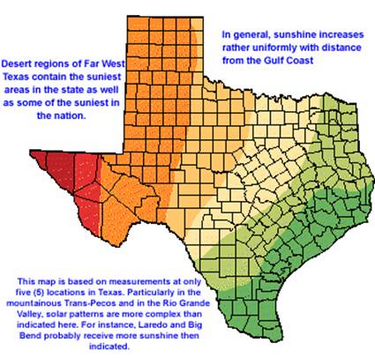From the Senator's Desk . . .
October 15, 2009
Throughout the years, the U.S. has become more and more dependant on foreign oil. Today, our country imports two-thirds of its oil from foreign sources, many of whom are governments overtly critical of the United States. We import 1.394 million barrels of oil per day from Saudi Arabia, 1.028 million barrels per day from Venezuela, and more than 500,000 barrels a day from Iraq. Every year, we literally send one trillion American dollars overseas to buy foreign oil. Incorporating more renewable sources into our nation's energy portfolio would both better ensure our security and boost our economy.
Written by Senator Eliot Shapleigh, www.shapleigh.org

Making El Paso the "Solar City" — Financing the Deal
Throughout the years, the U.S. has become more and more dependant on foreign oil. Today, our country imports two-thirds of its oil from foreign sources, many of whom are governments overtly critical of the United States. We import 1.394 million barrels of oil per day from Saudi Arabia, 1.028 million barrels per day from Venezuela, and more than 500,000 barrels a day from Iraq. Every year, we literally send one trillion American dollars overseas to buy foreign oil. Incorporating more renewable sources into our nation's energy portfolio would both better ensure our security and boost our economy.
This can be achieved through the use of photovoltaic (PV) modules (also known as solar panels). These modules are used as a component in a larger photovoltaic system to offer electricity for commercial and residential applications. PV modules covering only 0.3 percent of U.S. land could provide for all of our country's electricity consumption. Texas alone receives enough solar energy to supply one and a half times the world's current energy consumption.
Click here to view larger image.
Harnessing Texas' natural resources for the production of high efficiency, clean energy will not only help preserve the environment, it will boost the economy and help energy consumers save money. Today, Texas households pay 56 percent more in monthly energy costs than the national average.
For nearly a century, Texas has led the nation in hydrocarbon energy production. For the next hundred years, Texas is blessed once again to be able to lead in solar energy. All it takes is political will. In Texas, El Paso is literally the "Sun City"—we are best positioned to develop, market and lead the state in encouraging solar energy. With an average of 202 days of sun per year, El Paso ranks sixth in the country for the highest % annual possible sunshine average (85%). El Paso should be the next energy capitol of Texas.
As the map below illustrates, El Paso and the majority of Texas are perfectly suited for solar. Texas receives enough solar energy to supply one and a half times the world's current energy consumption.
Solar potential in Texas. The map was produced by the Railroad Commission of Texas.
Across the country, states like California are already promoting solar energy, giving $54 million in subsidies to utility companies for solar and other renewable resources. In California, cities have taken steps to help their citizens invest in solar power by helping them afford expensive initial costs to install the technology. In Palm Desert, the municipal government created a financing program that lends citizens the money and allows them to pay it back with interest over 20 years as part of their property taxes. Under this program, all homeowners are eligible for a solar upgrade and the obligation to pay the loan attaches to the house and any of its future owners. Similar programs exist in other California cities like Berkeley and Palm Springs.
Palm Desert invested $7.5 million to run a pilot program. By March 2009, nearly 100 households have been approved for solar panels. The monthly energy bill for a 3,400-square-foot home before its upgrades routinely cost more than $1,400 in summer months. After the upgrade, solar panels can produce more than enough energy in the daytime to power such a home— cutting the bill down by more than two thirds. Additional power is sent back to the grid and is credited on the costumer's utility bill.
In Arizona, the state government is requiring one percent of all new electrical generation to be from solar energy. In total, California and Arizona have announced almost 4,800 megawatts (MW) of large-scale solar projects, including 4,000 MW of Concentrating Solar Power (CSP) and Photovoltaic (PV) projects.
Texas is also doing its part to contribute to solar energy In some Texan cities, utilities are already looking at increased use of solar cells as an alternative source of power generation.
In Austin, their electric utility has already opened two photovoltaic generating stations that generate 315 kilowatts of electric power. The utility has also worked to expand a new rooftop solar program, and incent homeowners to produce their own power.
Also, in Dallas, power utility Oncor has set aside $2 million in incentives for homeowners to install solar water heaters in their homes. The solar panels can heat up to 80 percent of a household’s hot water. The utility announced that it will offer further rebates in 2009 to customers who install solar technology in their residences, offering up to $2.46 per watt for up to 10 kilowatts produced in the home. The company said it will spend $18.5 million in a campaign to increase awareness of PV technology, and train installation and maintenance contractors.
In 2008, 25 U.S. cities won an award for their solar technology adoption at the local level. Houston, Austin, and San Antonio were among the 25 cities chosen for the award. In the upcoming year, El Paso needs to be included in this list. For several years, our Senate office has asked El Paso Electric (EPEC) to take much more aggressive steps to lower costs, allow consumers to generate and sell solar power, and put El Paso on the map. Today, changing EPEC from a 1950s electric company to a 21st century energy company must now be a top community priority. Becoming a solar city consists of a significant increase in residential solar power use, large-scale solar installations, as well as an increase in public awareness through promotions and citywide education.
House Bill 1937 from the most recent legislative session gives cities a new tool for helping homeowners to make their homes more energy efficient or to install renewable energy devices on their homes. This bill was modeled after similar municipal financing programs in other cities around the country (e.g., Berkeley, San Diego).
H.B. 1937 authorizes a municipality to create a district within which property owners and authorized municipal officials may enter into contracts to assess properties to finance the energy efficiency improvements. The program allows municipal governments to sell bonds and use the proceeds to make a loan to a homeowner or business that can cover the up-front cost of energy efficiency improvements and/or a solar array. H.B. 1937 allows a municipality to impose an assessment only with the consent of the owner of the assessed property at the time of the assessment. Property owners then pay back the loan through a voluntary line item on their property bills at a low fixed interest rate (in some cases, a zero percent interest rate) over a 20-year period. The loan is tied to the property, which means that payment is tied to the property itself if the owner moves away.
H.B. 1937 gives the City of El Paso a tremendous tool to encourage and promote residential power use. Improving how El Pasoans use and generate energy will have a significant positive impact on our state's environment.
Since the early days of the Sun Carnival, our community has been the "Sun City." Now, it's time to move into the 21st century and make El Paso the next Solar Capitol of Texas.
![]()
![]()
Related Stories
